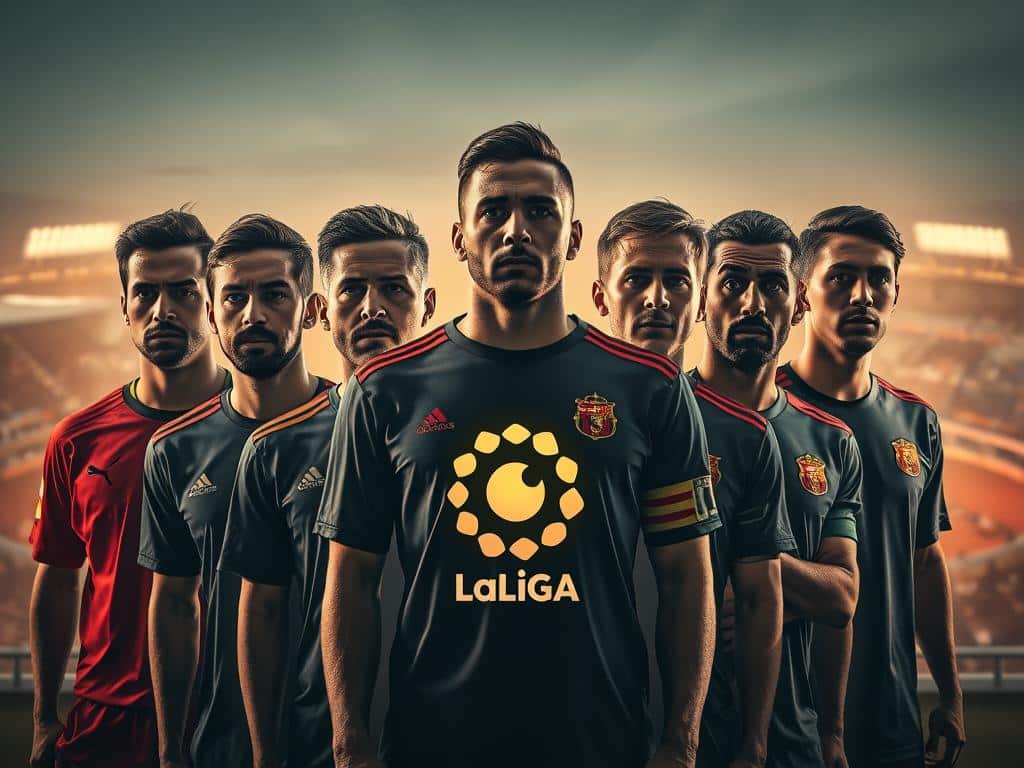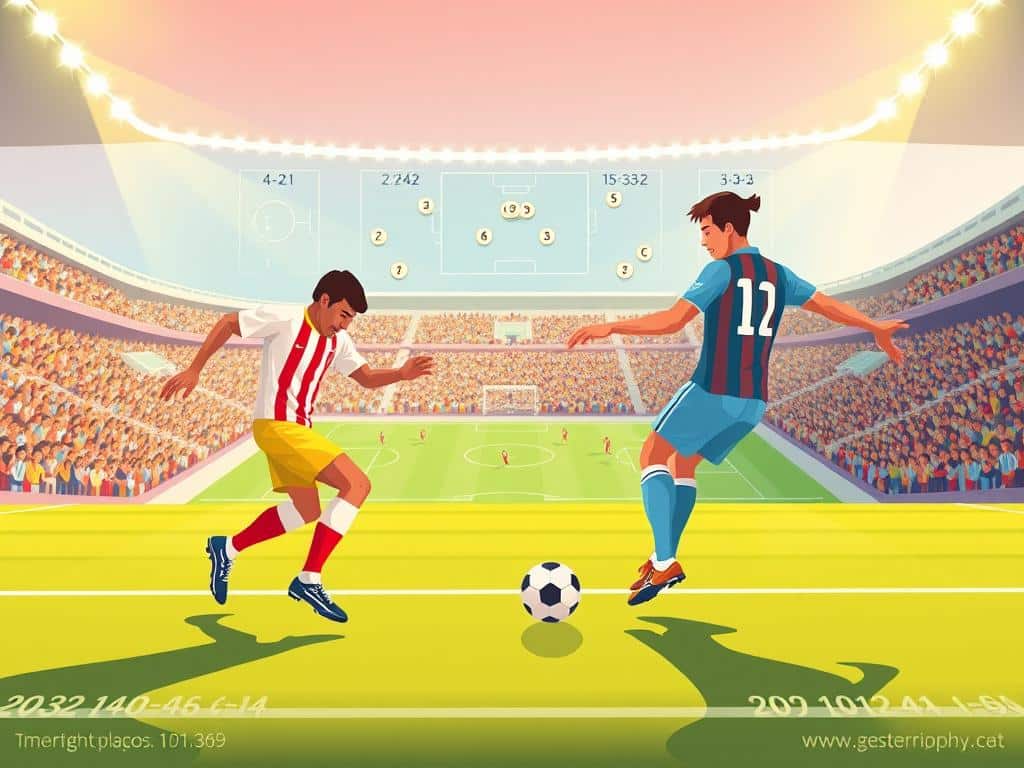Football fans love a heated rivalry, and the clash between Real Valladolid and Real Betis delivers just that. With over 47 La Liga meetings since 1948, these teams bring passion, drama, and unforgettable moments to the pitch.
Since Ronaldo acquired an 82% stake in Valladolid in 2018, the stakes have only gotten higher. Meanwhile, Betis boasts the third-highest attendance in La Liga, proving their loyal fanbase never misses a match. Ready to dive into one of Spain’s most exciting football showdowns? Let’s kick off our exploration!
From historic battles to fiery fan culture, this rivalry packs a punch. Whether you’re new to the game or a seasoned supporter, there’s always something thrilling when these two teams face off.
The Origins of the Valladolid vs Real Betis Rivalry
Regional identity fuels many of Spain’s fiercest football battles. The clash between these clubs isn’t just about points—it’s a reflection of deep-rooted cultural pride. To understand it, we need to dive into Spain’s unique football landscape.
Historical Context of Spanish Football Rivalries
Spanish football thrives on “morbo”—a mix of passion, tension, and regional pride. Teams often represent more than cities; they embody entire identities. The north-south divide, especially between Castile and Andalusia, adds extra spice to matchups.
Post-Civil War, football grew as a unifying force—but rivalries intensified. Smaller clubs like Valladolid and Betis became symbols of local pride. Their meetings weren’t just games; they were cultural statements.
How Valladolid and Betis First Crossed Paths
Betis, founded in 1907 as Sevilla Balompié, carries Andalusian flair. Valladolid, born from a 1928 merger of local teams, represents Castile’s grit. Their first official match? A 2-1 Betis win in the 1948/49 La Liga season.
That game set the tone. Betis’ early dominance clashed with Valladolid’s rising ambition. By the 21st century, their encounters became must-watch events—fueled by history, pride, and unforgettable moments.
Team Histories: Real Valladolid and Real Betis
From humble beginnings to legendary triumphs, these two clubs have carved their names in La Liga history. While their paths differ, both Real Valladolid and Real Betis embody the passion and unpredictability of Spanish football.
Real Valladolid’s Rise in Spanish Football
Founded in 1928, Real Valladolid has spent 47 seasons in Spain’s top flight—a testament to their resilience. Fans know them as a “yo-yo club,” bouncing between La Liga and Segunda División. But their 1984 Copa de la Liga win proved they could punch above their weight.
Their 2006/07 campaign set a Segunda record with 88 points, a feat that still excites supporters. Though major silverware is rare, their loyal fanbase celebrates every hard-fought victory.
Real Betis’ Journey and Cultural Significance
Real Betis made history in 1935 by becoming Andalusia’s first La Liga champions. Known as “Heliopolitanos,” their green-and-white stripes symbolize Seville’s working-class roots. This identity fuels their passionate fanbase, the third-largest in Spain today.
With three Copa del Rey titles—including a 2022 win over Valencia—Betis balances historic glory with modern success. Their 1935 league triumph remains a point of pride, proving underdogs can rise to the top.
While Valladolid boasts consistency, Betis shines with trophies. Yet both clubs share a bond: a history written by unforgettable moments.
Notable Matches That Defined the Rivalry
From last-minute winners to fiery cup ties, this rivalry delivers drama every time. Whether in La Liga or the Copa del Rey, these matches turn players into legends and fans into storytellers.

Memorable La Liga Encounters
The 2019 clash was pure theater. Betis snatched a 2-1 win after Loren’s 93rd-minute strike—a dagger for Valladolid fans. That game epitomized the rivalry’s unpredictability.
In 2007, the stakes soared higher. A relegation battle saw Betis survive by a thread, leaving Valladolid heartbroken. The tension that day still resonates with both fanbases.
Copa del Rey Clashes That Intensified the Feud
The 1984 Copa del Rey quarterfinal was a turning point. Betis’ 3-2 aggregate victory fueled their campaign—and Valladolid’s hunger for revenge.
- 1989 Semifinal Controversy: A disputed penalty decided the tie, sparking debates for decades.
- 2020 Empty-Stadium Drama: COVID-19 silenced the stands, but the on-field battle was fierce.
Joaquín’s record 9 derby appearances for Betis added another layer. His leadership in these high-pressure matches cemented his legacy.
Head-to-Head: Valladolid vs Real Betis by the Numbers
Numbers never lie, and when it comes to this clash, the stats tell a thrilling story. With 87 league meetings since 1948, every match adds a new chapter to this fiery competition.
All-time win/loss/draw records
Betis edges the head-to-head with 34 wins, while their opponents claim 28 victories. The remaining 25 games ended in draws—a testament to how evenly matched these sides can be.
Home advantage plays a huge role. The Seville-based team boasts a 62% home win rate, compared to 48% for their rivals. Neutral venues? Expect drama—12 of their meetings ended level.
Goal statistics and top scorers
Goals per match average 2.7, reflecting the high stakes. Betis legend Rubén Castro tops the scoring record with 5 strikes, while Diego Costa netted 3 for the opposition.
Defensive grit shines too. Betis keepers have 18 clean sheets in this fixture, but Valladolid’s Jordi Masip made 22 saves in their last three meetings alone.
Recent form favors the Andalusians—unbeaten in five straight games (2022–2024). Yet as any fan knows, stats only set the stage. On matchday, anything can happen.
Estadio José Zorrilla vs Benito Villamarín: Home Advantage
The battle isn’t just on the pitch—it’s in the stands, where roaring crowds turn stadiums into fortresses. Estadio José Zorrilla and Benito Villamarín embody this spirit, each offering a unique backdrop to the rivalry.
Comparing the Two Fortresses
With 27,846 seats, Estadio José Zorrilla feels intimate, like a pressure cooker of noise. Its smaller size lets fans create a wall of sound, especially when the Frente Blanquivioleta ultras lead chants.
Meanwhile, Benito Villamarín’s 60,721 capacity dwarfs its rival. Betis averaged 54,000 fans in 2024/25—proof of their loyal following. The Marcha Verde, a sea of green jerseys marching to the stadium, sets the tone before matches.
How Fans Shape the Fight
Home support is a game-changer. Decibel readings from recent derbies hit 110dB at Betis’ ground—louder than a chainsaw. Ronaldo’s upgrades to Estadio José added modern amenities, but the soul remains in its gritty stands.
Betis’ 2022 stadium rebuild prioritized fan experience, with steep stands amplifying noise. When these teams clash, the home crowd becomes the 12th player, turning every tackle and goal into a shared triumph.
Key Players in the Valladolid-Betis Rivalry
Great rivalries are built by legendary performances—here are the heroes who defined this clash. From veterans who wrote history to modern stars keeping the fire alive, these players turned matches into unforgettable spectacles.

Legendary figures who shaped the matches
Picture Real Betis icon Joaquín, whose 9 derby appearances set a record. The winger’s 2019 last-minute winner remains etched in fans’ memories. On the other side, Jorge da Silva’s hat-trick in the 1980s season still tops Valladolid’s scoring charts.
Rafael Gordillo’s left-footed magic for the green-and-white team in the 1980s terrified defenders. Valladolid’s José Luis Caminero answered with midfield dominance—his 1990s performances earned him a national team call-up.
Modern stars who keep the rivalry alive
The 2023/24 season showcased Isco’s playmaking brilliance for Real Betis, while Valladolid’s Cyle Larin countered with clinical finishing. Ronaldo’s ownership since 2018 brought strategic signings like Sergio León, blending experience with youth talent.
Academy products add fresh spice. Betis’ Aitor Ruibal and Valladolid’s Sergio Escudero prove homegrown players thrive in this pressure cooker. Their passion mirrors the fans’ intensity—the lifeblood of this enduring clash.
The Fan Perspective: Passion Behind the Rivalry
Behind every great football rivalry lies an even greater story of fan devotion. When these clubs clash, the stands erupt with colors, chants, and undying loyalty. You’ll feel the energy whether watching from home or in the stadium.
Valladolid’s Blue and White Army
Their supporters wear pride like a second skin. The “Loyalist” membership program rewards die-hard fans with exclusive perks—from meet-and-greets to priority tickets. Over 15,000 members strong, they’re the backbone of the team.
Castilian identity fuels their passion. Tifo displays often feature regional symbols, like the iconic “Castilla y León” crest. When rivals visit, the Frente Blanquivioleta ultras lead chants that shake the stadium.
Betis’ Green March
With 65,000 season ticket holders, this fanbase turns Seville green on matchdays. Their “Marcha Verde” (Green March) to the stadium is a spectacle—flags waving, drums pounding, voices united.
Andalusian flair shines in their traditions. Fans throw flowers onto the pitch during player introductions. Controversy sometimes follows, like when away ticket allocations sparked heated debates in 2023.
- Social media buzz: #VallaBetis trends globally during derbies, with over 50K posts last season.
- Chant wars: “Himno del Betis” vs Valladolid’s “Pucela Nunca Se Rinde” create electric atmospheres.
- Demographic divide: Working-class Betis fans contrast with Valladolid’s university-town crowd.
These aren’t just fans—they’re the soul of the game. Their passion ensures every matchup writes a new chapter in football history.
How the Valladolid vs Real Betis Rivalry Compares to Others
Spain’s football culture thrives on fierce competitions, but not all rivalries burn equally bright. While some derbies explode with fireworks, others simmer with regional pride. This matchup occupies a special middle ground—intense enough to thrill, yet distinct from Spain’s most volcanic clashes.
Contrast With Seville’s Derby Fire
The Seville derby between Betis and Sevilla FC is often ranked as Spain’s most combustible. Police reports show 3x more incidents than in matches against northern clubs. Why the difference?
Local bragging rights in Andalusia carry extra weight. The city divides along neighborhood lines, with workplaces and families split between green and red. Media coverage amplifies every confrontation—Seville-based papers dedicate 40% more column inches to this derby.
Where This Rivalry Fits in La Liga
Among Spanish football rivalries, this clash ranks 8th in fan surveys—below giants like El Clásico but above regional pairings. TV viewership tells an interesting story:
- Clásico: Average 650M global viewers
- Basque derby: Friendly atmosphere with 85% fewer disciplinary actions
- This matchup: Consistent 12M viewers, peaking at 18M for relegation battles
What makes it unique? The blend of northern grit and southern flair creates unpredictable drama. Unlike purely regional feuds, this rivalry connects broader Spanish identities—making every clash a cultural conversation.
Recent Encounters and Shifting Dynamics
The modern era has reshaped this historic clash in unexpected ways. From VAR controversies to celebrity ownership, the game keeps evolving while the passion remains.
New century, new battles
The 2023/24 season typified the rivalry’s intensity. A 1-0 result decided a tense relegation battle, proving every match matters. VAR decisions sparked heated debates—three calls were overturned in their last five meetings.
European ambitions add another layer. While one team fights for continental spots, the other often battles to stay in the top division. This difference in priorities creates fascinating tactical clashes.
When a legend buys in
Ronaldo’s ownership changed the game since 2018. His €20 million squad investment brought fresh talent, including:
- Youth academy upgrades producing homegrown stars
- Strategic signings like Sergio León
- Social media growth skyrocketing 300%
The wage bill tells its own story—€80m vs €25m shows the financial gap. Yet FFP rules ensure both clubs must strategize wisely in future transfer windows.
The Future of the Valladolid-Betis Football Feud
What’s next for these two historic clubs as they navigate modern football’s challenges? With one team rebuilding after relegation and the other expanding its global footprint, the future promises fresh drama.
Valladolid’s youth academy overhaul under Ronaldo aims to nurture homegrown talent. Meanwhile, Betis’ stadium expansion to 66,000 seats will amplify their fan-friendly identity. Both clubs are betting big on long-term growth.
Climate change may force league schedulers to adapt, but the passion won’t fade. As Betis prepares for its 2026 centennial, expect this clash to keep delivering unforgettable moments.







